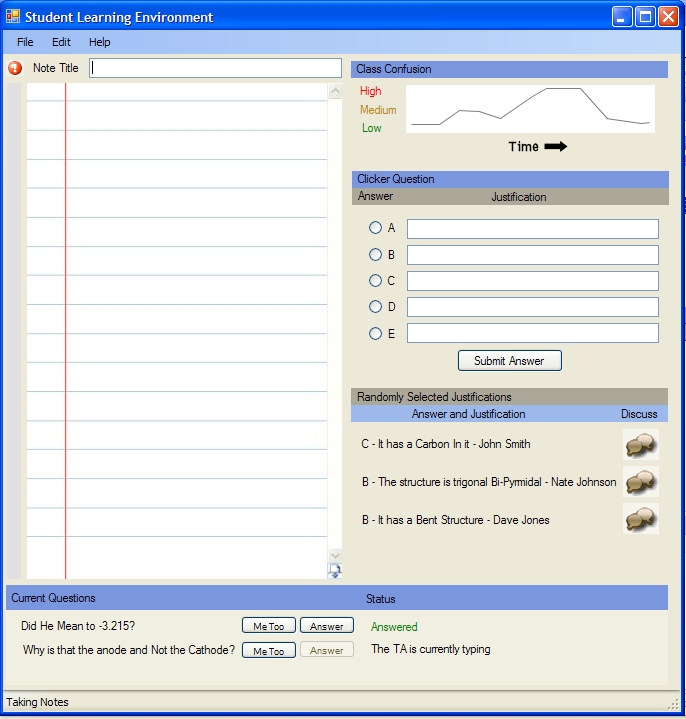Collaboration Progress Report #1
Proposed Project Title: SLE (Student Learning Environment)
Nathan Campbell, Lisa Doan, Kirill Kireyev Malte Winkler
4/3/06
Current Progress
Our project is moving swiftly and on schedule. By using the information gathered during the independent research we were able to make our first prototype of the Student Learning Environment (proposed name).
As described in our project proposal, our project is to create a tool that allows students in large classrooms to have a more collaborative experience while not hindering the professor’s lectures.
We have identified some challenges that large lectures present. The largest problem with these large classes is the student’s inability to ask questions during the lecture. This problem occurs because students are worried about interrupting class or believe that their question is not valid to ask during the class.
After interviewing professors and instructors we also have determined that the instructor’s attention is limited. Often times they have a certain place in the material they have to reach before the end of the class period and therefore can only spend a very limited amount of time answering questions from students.
Our research into the student response systems such as “clickers” demonstrated that many instructors feel they are great to gauge the students understanding of material and work on points that the class finds confusing. Without “clickers” the teachers did not have an accurate gauge of how well the students understood the material making it difficult to gauge the students understanding.
The final problem we identified in large lecture halls is the lack of any record of the lecture taking place besides the notes the students took. Students and instructors have very limited material to review the discourse, reasoning and opinions of the class.
Besides noting the negative aspects of large lecture halls we reviewed and compiled a list of opportunities that are presented by these large classrooms. The large number of students in class provides a great body of knowledge. This could be used to help improve each students understanding of different subjects by allowing students to work with each other to solve problems.
Another unexploited resource that is available in most large classrooms is the Teaching Assistants that are in the lecture halls. The TAs have a deep knowledge of the subjects at hand but are currently unavailable for students to talk to during the class period. We plan to use this fact to help us make the TAs easier to contact and ask questions without interrupting class.
During our independent research, and particularly after witnessing a class taught by Carl Weinman in which “clickers” were used, we noted that it would be a great enhancement if clickers also allowed for justifications. Justifications would help the instructor understand incorrect reasoning and help lead the students back on track.
We also found that students do want to ask questions, they just do not have a good way to ask them. We plan to empower the student with a tool that allows them to ask any question they want without interrupting the professor. Our hope is that this will allow students to better understand each and every lecture without get lost on small points they did not understand, instead there question could be answered quickly allowing that student to continue to understand the rest of the material presented in lecture.
Project Prototype V.01 - SLE
We have built a prototype of our project that is currently just a user interface, but it demonstrates many of the ideas that we would like the final project to entail.
SLE provides an area for students to take notes and add question markers next to any parts they did not understand. This would not only be used to help the student look back at parts of there notes they did not understand but would also be used to calculate the class confusion. This particular meter can give the professor, TAs and students a way to gauge the classes understanding.
Another function provided by the SLE is the way the students can ask questions in which they can discuss questions with each other and the TAs moderate in order to answer questions quickly to help the students. The students are also given the option to simply click the “me too” button which allows them to say “hey, I have the same question”. This prioritizes the questions for the TAs so they can answer the question that 10 students have versus the question that just one student has.
We also have built in our own version of the clicker. This response system requires that the student give a justification for the answer they have chosen. Then will the question is still being presented the student is given some randomly selected answers and their justifications. The student is given the option to discuss any of the answers and justifications with the student who wrote that particular answer. Our hope is that this will keep a student from succumbing to the “beaten path”.
The “beaten path” problems occurs when a student justifies their incorrect answer with their own reasoning then they are corrected by the teacher, but when they approach the problem again they use the old incorrect path of reasoning that they used in the first place.
This is only our first version of our prototype but we feel it has given us a great start to refine our ideas to create a better tool to help students collaborate in a large classroom setting.
Below is an figure demonstrating our first prototype.

Project Prototype V.01 (SLE)
Current Schedule
- Thursday 4/6/06 – Provide criticism of prototype, work out entire layout of the program
- Week of 4/10/06 – Work on new prototype
Group Work To Be Completed
The following tasks still have to be completed:
- Finalize Technical details (what technology to use)
- Create overall program layout, finalize specification
- Design the prototype in the desired technology